+ Open data
Open data
- Basic information
Basic information
| Entry | Database: PDB / ID: 6v3n | ||||||
|---|---|---|---|---|---|---|---|
| Title | Crystal structure of CDYL2 in complex with H3K27me3 | ||||||
 Components Components |
| ||||||
 Keywords Keywords | GENE REGULATION / chromodomain / epigenetics / Structural Genomics / Structural Genomics Consortium / SGC / PROTEIN BINDING | ||||||
| Function / homology |  Function and homology information Function and homology informationhistone H3K27me3 reader activity / histone H3K9me2/3 reader activity / : / Chromatin modifying enzymes / telomere organization / Interleukin-7 signaling / RNA Polymerase I Promoter Opening / epigenetic regulation of gene expression / Assembly of the ORC complex at the origin of replication / Regulation of endogenous retroelements by the Human Silencing Hub (HUSH) complex ...histone H3K27me3 reader activity / histone H3K9me2/3 reader activity / : / Chromatin modifying enzymes / telomere organization / Interleukin-7 signaling / RNA Polymerase I Promoter Opening / epigenetic regulation of gene expression / Assembly of the ORC complex at the origin of replication / Regulation of endogenous retroelements by the Human Silencing Hub (HUSH) complex / DNA methylation / Condensation of Prophase Chromosomes / Chromatin modifications during the maternal to zygotic transition (MZT) / SIRT1 negatively regulates rRNA expression / HCMV Late Events / ERCC6 (CSB) and EHMT2 (G9a) positively regulate rRNA expression / PRC2 methylates histones and DNA / Regulation of endogenous retroelements by KRAB-ZFP proteins / Defective pyroptosis / HDACs deacetylate histones / Regulation of endogenous retroelements by Piwi-interacting RNAs (piRNAs) / RNA Polymerase I Promoter Escape / Transcriptional regulation by small RNAs / Formation of the beta-catenin:TCF transactivating complex / Activated PKN1 stimulates transcription of AR (androgen receptor) regulated genes KLK2 and KLK3 / RUNX1 regulates genes involved in megakaryocyte differentiation and platelet function / HDMs demethylate histones / NoRC negatively regulates rRNA expression / B-WICH complex positively regulates rRNA expression / PKMTs methylate histone lysines / Pre-NOTCH Transcription and Translation / Meiotic recombination / Activation of anterior HOX genes in hindbrain development during early embryogenesis / RMTs methylate histone arginines / Transcriptional regulation of granulopoiesis / HCMV Early Events / structural constituent of chromatin / transcription corepressor activity / nucleosome / nucleosome assembly / HATs acetylate histones / RUNX1 regulates transcription of genes involved in differentiation of HSCs / Factors involved in megakaryocyte development and platelet production / MLL4 and MLL3 complexes regulate expression of PPARG target genes in adipogenesis and hepatic steatosis / chromatin organization / Senescence-Associated Secretory Phenotype (SASP) / Oxidative Stress Induced Senescence / gene expression / Estrogen-dependent gene expression / cadherin binding / protein heterodimerization activity / Amyloid fiber formation / protein-containing complex / DNA binding / extracellular exosome / extracellular region / nucleoplasm / nucleus / membrane Similarity search - Function | ||||||
| Biological species |  Homo sapiens (human) Homo sapiens (human) | ||||||
| Method |  X-RAY DIFFRACTION / X-RAY DIFFRACTION /  SYNCHROTRON / SYNCHROTRON /  MOLECULAR REPLACEMENT / Resolution: 2.7 Å MOLECULAR REPLACEMENT / Resolution: 2.7 Å | ||||||
 Authors Authors | Qin, S. / Tempel, W. / Arrowsmith, C.H. / Bountra, C. / Edwards, A.M. / Min, J. / Structural Genomics Consortium (SGC) | ||||||
 Citation Citation |  Journal: Cell Chem Biol / Year: 2020 Journal: Cell Chem Biol / Year: 2020Title: Structural Basis for the Binding Selectivity of Human CDY Chromodomains. Authors: Dong, C. / Liu, Y. / Lyu, T.J. / Beldar, S. / Lamb, K.N. / Tempel, W. / Li, Y. / Li, Z. / James, L.I. / Qin, S. / Wang, Y. / Min, J. | ||||||
| History |
|
- Structure visualization
Structure visualization
| Structure viewer | Molecule:  Molmil Molmil Jmol/JSmol Jmol/JSmol |
|---|
- Downloads & links
Downloads & links
- Download
Download
| PDBx/mmCIF format |  6v3n.cif.gz 6v3n.cif.gz | 78.1 KB | Display |  PDBx/mmCIF format PDBx/mmCIF format |
|---|---|---|---|---|
| PDB format |  pdb6v3n.ent.gz pdb6v3n.ent.gz | 57.9 KB | Display |  PDB format PDB format |
| PDBx/mmJSON format |  6v3n.json.gz 6v3n.json.gz | Tree view |  PDBx/mmJSON format PDBx/mmJSON format | |
| Others |  Other downloads Other downloads |
-Validation report
| Summary document |  6v3n_validation.pdf.gz 6v3n_validation.pdf.gz | 448.9 KB | Display |  wwPDB validaton report wwPDB validaton report |
|---|---|---|---|---|
| Full document |  6v3n_full_validation.pdf.gz 6v3n_full_validation.pdf.gz | 449.2 KB | Display | |
| Data in XML |  6v3n_validation.xml.gz 6v3n_validation.xml.gz | 8.7 KB | Display | |
| Data in CIF |  6v3n_validation.cif.gz 6v3n_validation.cif.gz | 11.1 KB | Display | |
| Arichive directory |  https://data.pdbj.org/pub/pdb/validation_reports/v3/6v3n https://data.pdbj.org/pub/pdb/validation_reports/v3/6v3n ftp://data.pdbj.org/pub/pdb/validation_reports/v3/6v3n ftp://data.pdbj.org/pub/pdb/validation_reports/v3/6v3n | HTTPS FTP |
-Related structure data
| Related structure data |  2mj8C 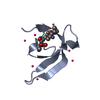 6v2dC 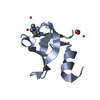 6v2hC  6v2rC  6v2sC 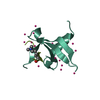 6v41C  6v8wC  4haeS S: Starting model for refinement C: citing same article ( |
|---|---|
| Similar structure data |
- Links
Links
- Assembly
Assembly
| Deposited unit | 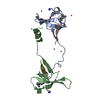
| ||||||||
|---|---|---|---|---|---|---|---|---|---|
| 1 | 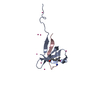
| ||||||||
| 2 | 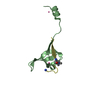
| ||||||||
| Unit cell |
|
- Components
Components
| #1: Protein | Mass: 7695.596 Da / Num. of mol.: 2 / Fragment: chromodomain Source method: isolated from a genetically manipulated source Source: (gene. exp.)  Homo sapiens (human) / Gene: CDYL2 / Production host: Homo sapiens (human) / Gene: CDYL2 / Production host:  #2: Protein/peptide | Mass: 1645.944 Da / Num. of mol.: 2 / Source method: obtained synthetically / Source: (synth.)  Homo sapiens (human) / References: UniProt: P68431*PLUS Homo sapiens (human) / References: UniProt: P68431*PLUS#3: Chemical | ChemComp-UNX / Has ligand of interest | Y | Has protein modification | Y | |
|---|
-Experimental details
-Experiment
| Experiment | Method:  X-RAY DIFFRACTION / Number of used crystals: 1 X-RAY DIFFRACTION / Number of used crystals: 1 |
|---|
- Sample preparation
Sample preparation
| Crystal | Density Matthews: 4.41 Å3/Da / Density % sol: 72.1 % |
|---|---|
| Crystal grow | Temperature: 291 K / Method: vapor diffusion, sitting drop / pH: 5.5 Details: 1.6 M ammonium sulfate, 0.01 M magnesium chloride, 0.1 M sodium cacodylate |
-Data collection
| Diffraction | Mean temperature: 100 K / Serial crystal experiment: N | ||||||||||||||||||||||||
|---|---|---|---|---|---|---|---|---|---|---|---|---|---|---|---|---|---|---|---|---|---|---|---|---|---|
| Diffraction source | Source:  SYNCHROTRON / Site: SYNCHROTRON / Site:  APS APS  / Beamline: 19-ID / Wavelength: 0.9792368 Å / Beamline: 19-ID / Wavelength: 0.9792368 Å | ||||||||||||||||||||||||
| Detector | Type: ADSC QUANTUM 315 / Detector: CCD / Date: Oct 20, 2013 | ||||||||||||||||||||||||
| Radiation | Protocol: SINGLE WAVELENGTH / Monochromatic (M) / Laue (L): M / Scattering type: x-ray | ||||||||||||||||||||||||
| Radiation wavelength | Wavelength: 0.9792368 Å / Relative weight: 1 | ||||||||||||||||||||||||
| Reflection | Resolution: 2.7→44.65 Å / Num. obs: 9869 / % possible obs: 99.9 % / Redundancy: 13.6 % / CC1/2: 0.999 / Rmerge(I) obs: 0.085 / Rrim(I) all: 0.089 / Net I/σ(I): 26.8 | ||||||||||||||||||||||||
| Reflection shell |
|
- Processing
Processing
| Software |
| |||||||||||||||||||||||||||||||||||||||||||||||||||||||||||||||||||||||||||||||||||||||||||||||||||||||||||||||||||||||||||||||||||||||||||||||||||||||||||||||||||||||||||||||
|---|---|---|---|---|---|---|---|---|---|---|---|---|---|---|---|---|---|---|---|---|---|---|---|---|---|---|---|---|---|---|---|---|---|---|---|---|---|---|---|---|---|---|---|---|---|---|---|---|---|---|---|---|---|---|---|---|---|---|---|---|---|---|---|---|---|---|---|---|---|---|---|---|---|---|---|---|---|---|---|---|---|---|---|---|---|---|---|---|---|---|---|---|---|---|---|---|---|---|---|---|---|---|---|---|---|---|---|---|---|---|---|---|---|---|---|---|---|---|---|---|---|---|---|---|---|---|---|---|---|---|---|---|---|---|---|---|---|---|---|---|---|---|---|---|---|---|---|---|---|---|---|---|---|---|---|---|---|---|---|---|---|---|---|---|---|---|---|---|---|---|---|---|---|---|---|---|
| Refinement | Method to determine structure:  MOLECULAR REPLACEMENT MOLECULAR REPLACEMENTStarting model: PDB entry 4HAE Resolution: 2.7→44.65 Å / Cor.coef. Fo:Fc: 0.902 / Cor.coef. Fo:Fc free: 0.914 / SU R Cruickshank DPI: 0.318 / Cross valid method: THROUGHOUT / SU R Blow DPI: 0.326 / SU Rfree Blow DPI: 0.244 / SU Rfree Cruickshank DPI: 0.244
| |||||||||||||||||||||||||||||||||||||||||||||||||||||||||||||||||||||||||||||||||||||||||||||||||||||||||||||||||||||||||||||||||||||||||||||||||||||||||||||||||||||||||||||||
| Displacement parameters | Biso mean: 90.04 Å2
| |||||||||||||||||||||||||||||||||||||||||||||||||||||||||||||||||||||||||||||||||||||||||||||||||||||||||||||||||||||||||||||||||||||||||||||||||||||||||||||||||||||||||||||||
| Refinement step | Cycle: LAST / Resolution: 2.7→44.65 Å
| |||||||||||||||||||||||||||||||||||||||||||||||||||||||||||||||||||||||||||||||||||||||||||||||||||||||||||||||||||||||||||||||||||||||||||||||||||||||||||||||||||||||||||||||
| LS refinement shell | Resolution: 2.7→2.73 Å
| |||||||||||||||||||||||||||||||||||||||||||||||||||||||||||||||||||||||||||||||||||||||||||||||||||||||||||||||||||||||||||||||||||||||||||||||||||||||||||||||||||||||||||||||
| Refinement TLS params. | Refine-ID: X-RAY DIFFRACTION
| |||||||||||||||||||||||||||||||||||||||||||||||||||||||||||||||||||||||||||||||||||||||||||||||||||||||||||||||||||||||||||||||||||||||||||||||||||||||||||||||||||||||||||||||
| Refinement TLS group |
|
 Movie
Movie Controller
Controller




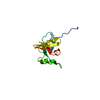
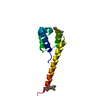
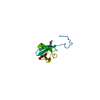
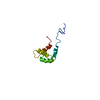

 PDBj
PDBj









